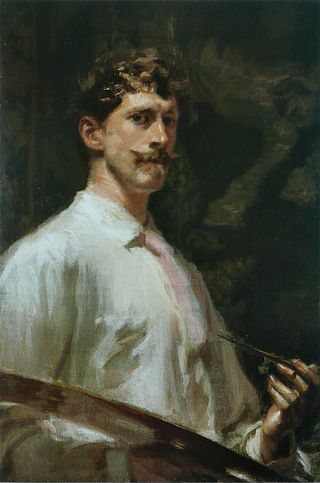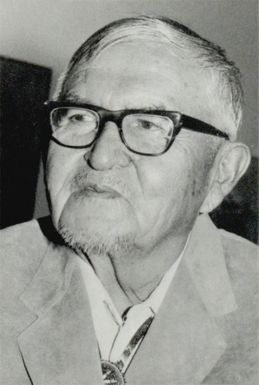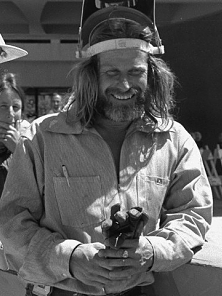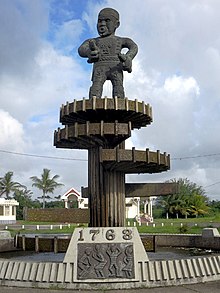Guyanese culture reflects the influence of African, Indian, Amerindian, British, Portuguese, Chinese, Creole, and Dutch cultures. Guyana is part of the mainland Caribbean region. Guyanese culture shares a continuum with the cultures of islands in the West Indies.

Sir Jacob Epstein was an American-British sculptor who helped pioneer modern sculpture. He was born in the United States, and moved to Europe in 1902, becoming a British subject in 1910.

Vladimir Yevgrafovich Tatlin was a Russian, Ukrainian and Soviet painter, architect and stage-designer. Tatlin achieved fame as the architect who designed The Monument to the Third International, more commonly known as Tatlin's Tower, which he began in 1919. With Kazimir Malevich he was one of the two most important figures in the Soviet avant-garde art movement of the 1920s, and he later became an important artist in the constructivist movement.

Frederick William MacMonnies was the best known expatriate American sculptor of the Beaux-Arts school, as successful and lauded in France as he was in the United States. He was also a highly accomplished painter and portraitist. He was born in Brooklyn Heights, Brooklyn, New York and died in New York City.

Coffij, also spelled as Coffy, Cuffy, Kofi, or Koffi, was an Akan man who was captured in his native West Africa and stolen for slavery to work on the plantations of the Dutch colony of Berbice in present-day Guyana. In 1763, he led a major slave revolt of more than 3,800 slaves against the colonial regime. Today, he is a national hero in Guyana.
Philip Henry Christopher Jackson CVO DL is a Scottish sculptor, noted for his modern style and emphasis on form. Acting as Royal Sculptor to Queen Elizabeth II, his sculptures appear in numerous UK cities, as well as Argentina and Switzerland.

George Segal was an American painter and sculptor associated with the pop art movement. He was presented with the United States National Medal of Arts in 1999.

Allan Capron Houser or Haozous was a Chiricahua Apache sculptor, painter, and book illustrator born in Oklahoma. He was one of the most renowned Native American painters and Modernist sculptors of the 20th century.

Marco Polo di Suvero, better known as Mark di Suvero, is an abstract expressionist sculptor and 2010 National Medal of Arts recipient.

Henry Spencer Moore was an English artist. He is best known for his semi-abstract monumental bronze sculptures which are located around the world as public works of art. Moore also produced many drawings, including a series depicting Londoners sheltering from the Blitz during the Second World War, along with other graphic works on paper.
Stanley Greaves is a Guyanese painter and writer who is one of the Caribbean's most distinguished artists. Writing in 1995 at the time of a retrospective exhibition to celebrate Greaves's 60th birthday, Rupert Roopnarine stated: "It may be that no major Caribbean artist of our time has been more fecund and versatile than Stanley Greaves of Guyana." Greaves himself has said of his own creativity:
I still don't talk about myself as making art! Other people do that. I am a maker of things. In the early days, I found empty matchboxes, cigarette boxes, bits of string, wire, empty boot-polish tins, whatever, and made things. Drawing was just another activity, and it still is. My favorite medium is still wood, of course. My hitherto secret preoccupation with writing poems, which has now come to light, is another form of making. Recently at the University of Birmingham, where I did a reading, I was asked if the paintings influenced the poetry, and I said, "No, they come from the same source."
Thaddeus G. Mosley is an American sculptor who works mostly in wood and is based in Pittsburgh, Pennsylvania.
Citizens or residents of the United Kingdom whose origins lie in Guyana are a part of the country's British Caribbean community. Guyana was a former British colony, British Guiana, responsible for moving large numbers of Africans and Indians for labour in the sugar industry. British Guyanese are notable for their contributions to literature and music.

Donald Cuthbert Locke was a Guyanese artist who created drawings, paintings and sculptures in a variety of media. He studied in the United Kingdom, and worked in Guyana and the United Kingdom before moving to the United States in 1979. He spent his last twenty years, perhaps the most productive and innovative period of his life, in Atlanta, Georgia. His eldest son is British sculptor Hew Locke.
Stewartville is a village district in Guyana on the Atlantic coast of West Demerara, just east of the mouth of the Essequibo River. There are four sections in the village: Stewartville Housing Scheme, Sarah Lodge, Stewartville Old Road and Stewartville Sea View.
Edward Rupert Burrowes was a Guyanese artist and art teacher who founded the Working People's Art Class (WPAC), the first established art institution in Guyana. The E R Burrowes School of Art, an undergraduate institution accredited by the University of Guyana, is named after him.
The Working People's Art Class (WPAC), founded by Edward Rupert Burrowes in 1945, was the first established art institution in the colony of British Guiana, now the country of Guyana. A number of well-known Guyanese artists were taught at the WPAC.

Emerson Augustus Samuels was a prominent Guyanese graphic artist. He is perhaps best known for his portrait of Guyana President Forbes Burnham, completed in August 1984, which hangs in the Parliament Chamber.
Oswald ("Ossie") Hussein is a Guyanese artist of Lokono (Arawak) descent. Though he occasionally works in other mediums, he is best known for his wooden sculptures, which explore various dimensions of Arawak Amerindian culture and tradition. Hussein first achieved national recognition when he won first prize in Guyana's National Exhibition of the Visual Arts in 1989, and since that time he has gone on to become one of Guyana's most celebrated artists and a leading figure in Guyanese sculpture. Along with his half-brother, George Simon, he is one of the most prominent members of the Lokono Artists Group. His work has been displayed in numerous exhibitions in Guyana, Barbados, and the United Kingdom.
Ann Compton is an art historian and an Affiliate in the History of Art, School of Culture & Creative Arts at the University of Glasgow. She has worked on a major project, 'Mapping the Practice and Profession of Sculpture in Britain and Ireland, 1851-1951', as Originator, Director and Editor. She is a Research Consultant on this project and is a member of the Sculpture Steering Panel at Art UK. She is a widely published author of and contributor to publications in her field. She is a member of the Advisory Board of the journal 'Public Monuments and Sculpture Association' (PMSA).











